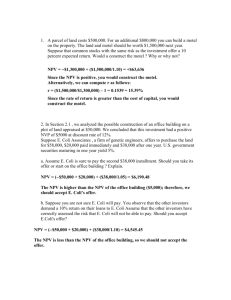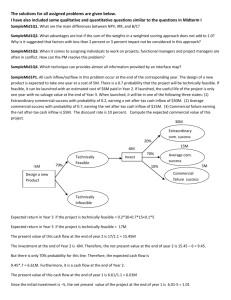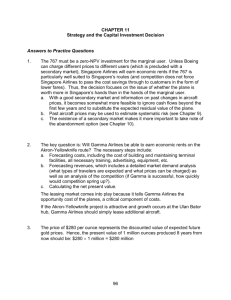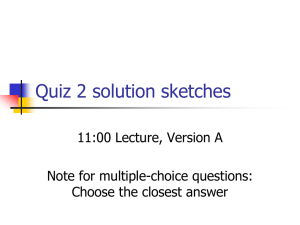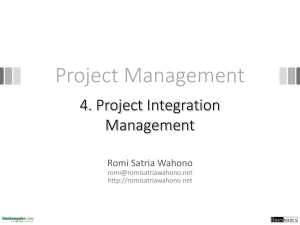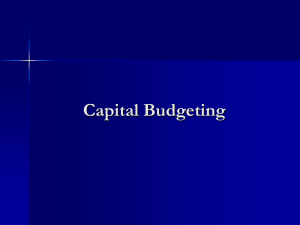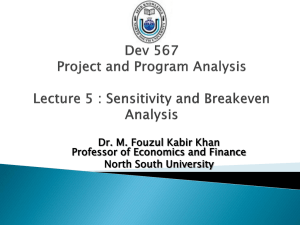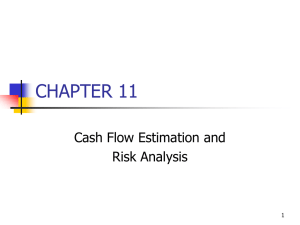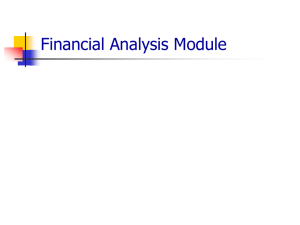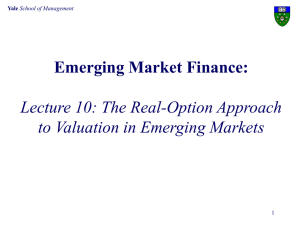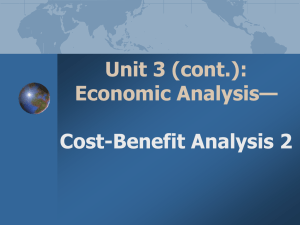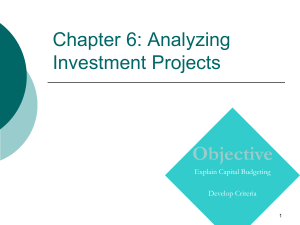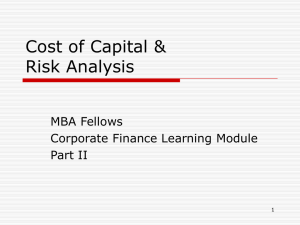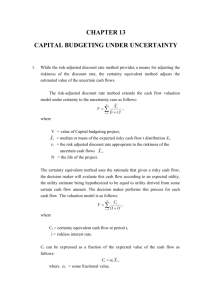Slides
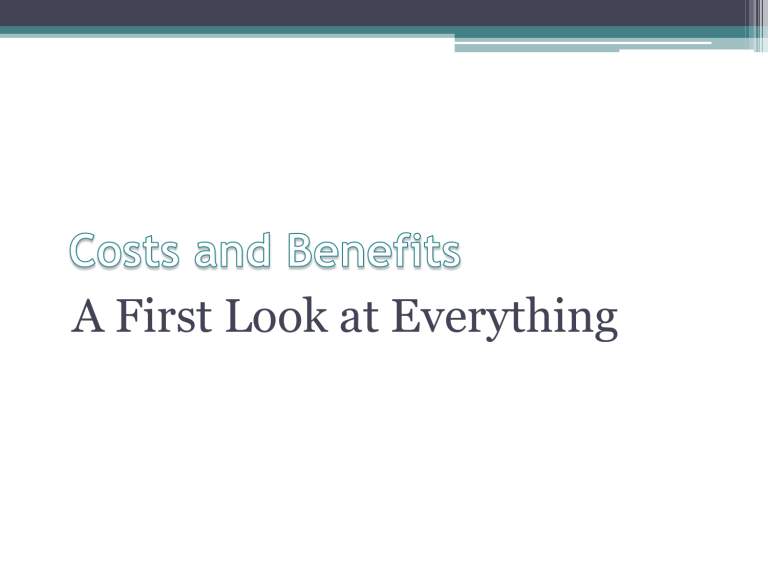
A First Look at Everything
Interest Rates and the Time Value of Money
• Time Value of Money
▫ Imagine a simple investment opportunity with the following cash flows (which are certain to occur).
Cost: $1,000 today
Benefit: $1,030 in one year
Can we judge the opportunity as valuable by noting that
$1,o3o > $1,000?
Money has two “units”
▫ The difference in value between money today and money in the future is “the time value of money.”
The Interest Rate:
An Exchange Rate Across Time
• The rate at which we can exchange money today for money in the future via the financial markets is determined by the current interest rate.
▫ Suppose the current annual risk free interest rate is
5%. By investing or borrowing at this rate, we can exchange (trade) $1.05 in one year for $1 today.
Risk Free Interest Rate (Discount Rate), r f
: The interest rate at which money can be borrowed or lent without risk.
Interest Rate Factor = 1 + r f
= 1.05 ($s tomorrow/$ today)
Discount Factor = 1 / (1 + r f
($s today/$ tomorrow)
) = 1/1.05 = $0.9524
▫ Investors are compensated for surrendering capital.
Previous Example
• Real investment opportunity
Cost: $1,000 today
Benefit: $1,030 in one year
$1,000 today becomes $1,030 in one year.
• Financial market, with an interest rate of 5%:
$1,000×(1+r f
) = $1,000×(1.05) = $1,050
$1,000 today becomes $1,050 in one year.
• What do we think of the investment opportunity?
Problem
• The cost of replacing a fleet of company trucks with more energy efficient vehicles is $100 million now.
• The cost is estimated to rise by $8.5 million next year.
• If the interest rate is 4%, what is the cost of a delay in terms of dollars next year?
Solution
• If the project were delayed, it’s cost next year will be:
▫ $100 million +$8.5 million = $108.5 million next year
• Compare this amount to the cost of replacing nowstated in dollars next year using the interest rate of
4%:
▫ $100 million × ($1.04 next year/$1 now) = $104 million next year
• The cost of a one year delay would be:
▫ $108.5 million – $104 million = $4.5 million next year
(future value)
Problem
• The cost of replacing a fleet of company trucks with more energy efficient vehicles is $100 million now.
• The cost is estimated to rise by $8.5 million next year.
• If the interest rate is 4%, what is the cost of a delay in terms of dollars now?
Solution
• We know if we delay, the project costs $108.5 million next year.
• Compare this amount to the cost of $100 million now using the interest rate of 4%:
▫ $108.5 million ÷ ($1.04 next year/$1 now) =
$104.33 million now
• The cost of a one year delay would be:
▫ $104.33 million – $100 million = $4.33 million now (present value). Why is the value different?
Discussion
• This example is the same as the example of trading gold for silver presented in the text.
• The price today of receiving $1.04 in one year is $1.
• The price today of receiving $1 today is of course $1.
• After we convert the values using these prices we do not ask whether to trade $X today for $Y in one year but rather should we trade $X today for $W today.
▫ Importantly: $Y in one year and $W today are equivalent.
• In these terms the choice is clear: is X W or X W?
• We will discuss and extend this idea as we go forward.
Present Value and the NPV Rule
• The net present value (NPV) of a project or investment is the difference between the present value of its benefits and the present value of its costs.
▫ Net Present Value
NPV
PV (Benefits)
PV (Costs)
PV (Benefits
Costs)
NPV
PV (incremental project cash flows)
The NPV Decision Rule
• When making an investment decision, take the alternative with the highest NPV. Choosing this alternative is equivalent to receiving its NPV in cash today.
▫ Accept all projects with a positive NPV. Accepting them is equivalent to receiving their NPV in cash today (firm value changes by the NPV of the project).
▫ Reject projects with a negative NPV. Accepting these projects is equivalent to reducing current wealth by their NPV.
Consider Three Projects (r
f
= 20%)
B
C
Project
A
Cash Today ($)
42
-20
-100
Cash in one year ($)
42
144
225
PV of Cash in one year
NPV ($ today) Project
A
B
C
Cash Today
42
-20
-100
NPV
• Although Project B has the highest NPV, what if we do not want to (can’t) spend the $20 for the cash outlay?
Would Project A be a better choice? Should this affect our choice of projects?
• What if you will need more than $144 next year, is
Project C then a good choice?
• As long as we are able to borrow and lend at today’s interest rate, Project B is superior whatever our preferences regarding the timing of the cash flows.
• Again, this follows from the same logic as the gold for silver trade in your text. Let’s see…
NPV and Individual Preferences
Project B and borrowing
Project B
Borrow
Total
Cash today
-20
62
42 (compare A: 42)
Cash in one year
144
-62 × 1.20 = -74.4
69.6 (compare A: 42)
Project B and saving Cash today
Project B
Save
Total
-20
-80
Cash in one year
144
80 × 1.20 = 96
-100 (compare C: -100) 240 (compare C: 225)
NPV and Individual Preferences
Project B and borrowing
Project B
Borrow
Total
Cash today
-20
120
100
Cash in one year
144
-144
0
• As we said, accepting a positive NPV project is equivalent to receiving that much cash today.
• This arrangement is equivalent to selling the right to project B and extracting all the value in the sale.
Separation Principle
• The only arbitrage free price for a financial security is for price to equal the present value of the cash flows
(expected to be) paid by that security.
• This means that in an arbitrage free market the NPV of buying or selling financial securities is zero.
▫ Every trade has a buyer and a seller, if the price is such that the NPV is not zero one party will object.
• Therefore, a real investment project can be evaluated independently of the financing necessary to pursue it.


